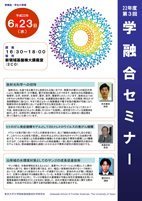AY2010 3rd Gakuyugo Seminar
- Date&Time:
- Jun 23, 2010 16:30~18:00
- Venue:
- Large Lecture Room (2C0), New Frontier Science Bldg.

Invitation to Synchrotron Radiation Science
Professor Yoshiyuki Amemiya
Synchrotron radiation is intense light emitted from electrons running at the speed of light. By interacting with the electrons in a material, we can observe the atomic and molecular structures and electronic states of the material. Synchrotron radiation has a wide range of applications in physics, chemistry, materials science, biology, pharmacy, medicine, and environmental studies. Synchrotron radiation has been available since the 1980s, and its brightness has increased exponentially with the progress of accelerator technology, making it possible to observe material structures and electronic states that were previously invisible. As a result, synchrotron radiation has become an indispensable measurement technology for advanced research in materials science. What can we see with synchrotron radiation? What can we see now that the brightness has increased? How will the synchrotron radiation source develop in the future? We will also introduce some of the experiments we are conducting in our laboratory. We hope that students from a wide range of fields who are interested in natural science will become familiar with synchrotron radiation.

Carcinogenic mechanism of human retroviruses as a model for human oncogenesis.
Professor Toshiki Watanabe
HTLV-1 causes adult T-cell leukemia (ATL) and there are about 1.1 million infected people in Japan. The virus is transmitted through breast milk, and about 5% of carriers develop leukemia more than 50 years later. The latter half of this process is consistent with the pathogenesis of human cancers and is a good model for studying the mechanism of carcinogenesis. This second half of the process is consistent with the pathogenesis of human cancers and is a good model for studying the mechanism of carcinogenesis.

Coral growth promotion technology as an aquatic environmental measure in coastal areas
Lecturer Yukio Koibuchi
In addition to supporting biodiversity, coral reefs are extremely important from the perspective of human use as a place for fishing and recreation. In addition, coral reefs form a wide range of shallow water areas where wave energy is attenuated by wave breaking, thus significantly reducing the external force of waves and protecting land from disasters. In this presentation, we will introduce coral growth promotion technology using electricity and present the results of field experiments on larval implantation and community growth, and laboratory experiments on photosynthesis and calcification, which were conducted with the aim of developing electrodeposited substrate materials using a sexual reproduction propagation method that enables mass propagation of coral seedlings.

